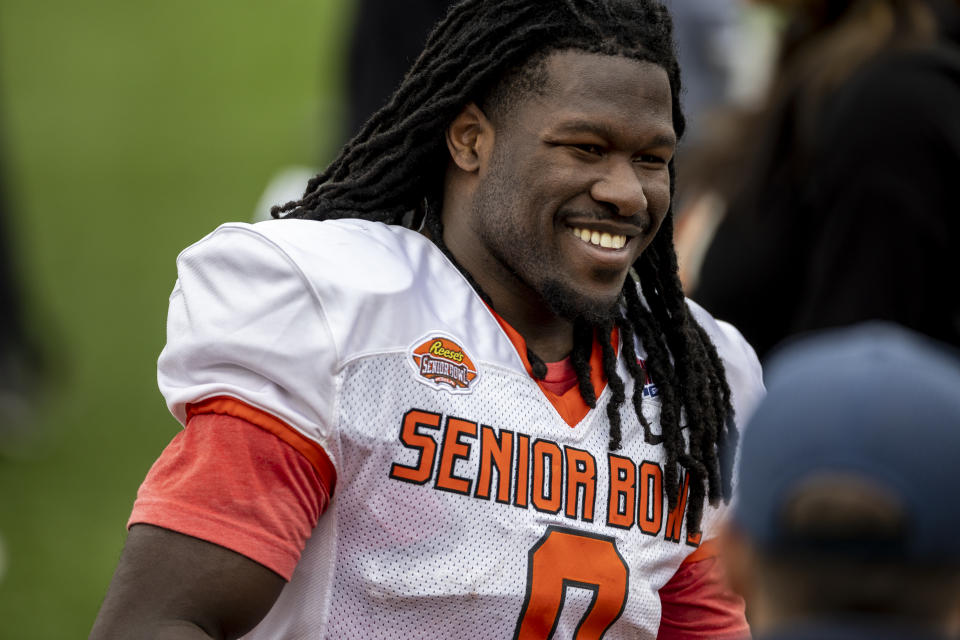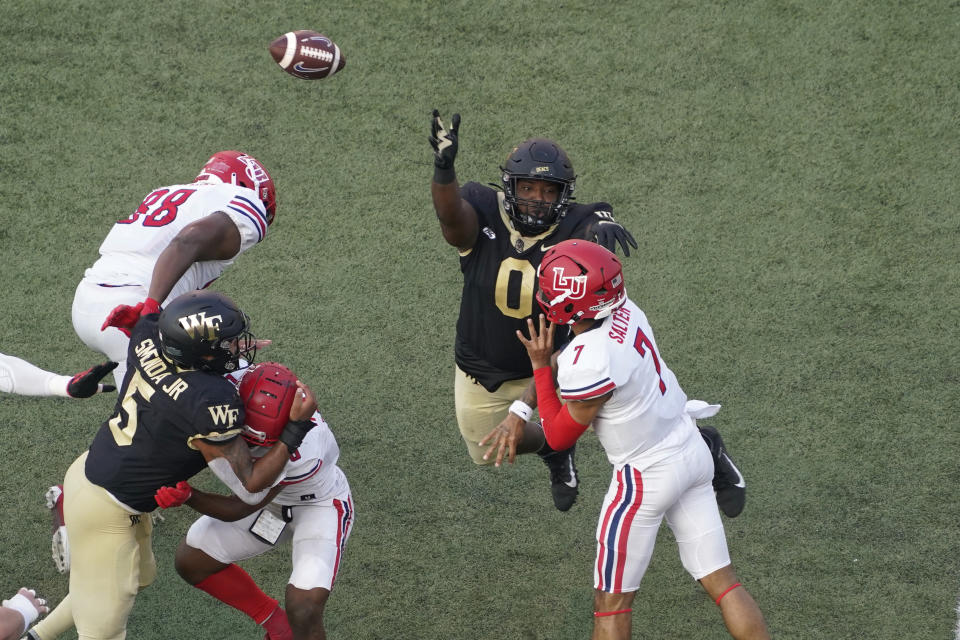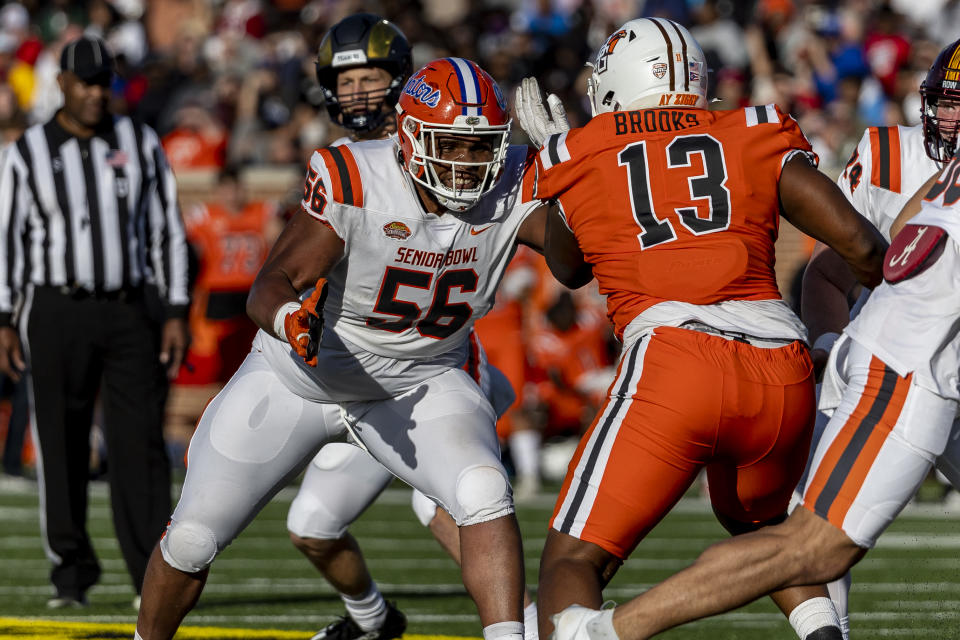Secret Superstars of the 2023 NFL draft: The best underrated prospects

Several NFL executives have already made it clear that they’re struggling to find as many as 20 prospects in the 2023 NFL draft class deserving of a first-round grade.
That may look like a pull quote, but it’s not entirely uncommon. Drafts like the 2023 one, which starts Thursday at 8:00 p.m. EST, are wider than they are tall, which means that while there aren’t a ton of obvious first-round guys, there are second- and third-day players who can make a difference on an NFL roster right away.
And that’s why it’s so important to have your scouting go all the way through all seven rounds and beyond. Ask the Super Bowl champion Kansas City Chiefs, who got their eventual starting running back (Rutgers’ Isiah Pacheco) in the seventh round. Or the Seattle Seahawks, who bagged starting cornerback Tariq Woolen out of UTSA in the fifth. And of course, there were few more interesting rookie stories in 2022 than the tale of San Francisco 49ers quarterback Brock Purdy, the most relevant “Mr. Irrelevant” in pro football history.
Looking ahead to the most talented sleepers in the 2023 draft class, there are prospects who have been pushed down in loaded position groups, those who need a bit of finishing work to fully unlock their NFL potential, and those who don’t have a total skill set, but who do a few things very well. They are all more than worthy of NFL consideration, and just because they’ll probably hear their names called in the late second or early third day of the draft, don’t automatically discount their NFL potential.
That’s a mistake the smartest NFL teams never make. Here are my most gifted sleepers — the “Secret Superstars” of the 2023 NFL draft.
Dorian Thompson-Robinson, QB, UCLA

(Jayne Kamin-Oncea-USA TODAY Sports)
DTR is probably a third-day guy because it’s a loaded quarterback class up top, and also because he’s got a bit of messy tape as a passer, but the positive traits stand out in some interesting ways. Were I an NFL quarterback coach, I’d love my team to take him in the fourth round, work with him for a year or so, and see what could be done. Thompson-Robinson can throw with anticipation, he’s not just a first-read guy, and I especially like his ability to work the deep ball with pace, touch, and velocity.
He’s not a perfect prospect, but there’s enough here for an NFL team to take a flier, work with him over time, and maybe there’s a next-level starter or top-flight backup in the mix.
Keaton Mitchell, RB, East Carolina

(Vasha Hunt-USA TODAY Sports)
Mitchell led all running backs in this class last season with 31 runs of 15 or more yards for 838 yards, and that’s not just based on straight-line speed — he also forced 75 missed tackles, which is pretty good for a 5-foot-8, 179-pound back. Mitchell’s size will limit his NFL opportunities and might take him off some boards entirely, but it’s also tough to argue with tape like this, where he shows such contact balance, lateral agility, and burst in the open field.
Roschon Johnson, RB, Texas

(Vasha Hunt-USA TODAY Sports)
The only reason Johnson didn’t get more reps in Texas’ backfield in recent years was because he was working behind Bijan Robinson, who might be the best running back prospect since Adrian Peterson. When Johnson did get the ball in 2022, he made the most of it, with 46 missed tackles forced and nine runs of 15 or more yards on just 94 attempts. At 6-foot-0 and 219 pounds, Johnson isn’t a projection as an NFL back — he absolutely looks the part, and we’d be talking about him quite a bit more had be been a part of any other NCAA backfield. This 21-yard run against Baylor shows you everything you need to know.
Xavier Hutchinson, WR, Iowa State

(AP Photo/Charlie Neibergall)
Last season, only Purdue’s Charlie Jones and Houston’s Nathaniel “Tank” Dell had more catches among receivers in this class than Hutchinson’s 107, which he produced on 161 targets for 1,171 yards and six touchdowns. Hutchinson is not a burner per se — he ran a 4.53 40-yard dash at the combine — but he’s got a gift for winning contested-catch battles at 6-foot-2 and 203 pounds, and he does it with more than just strength in the post. Hutchinson has a great sense of how to subtlety separate from tight coverage in those enclosed spaces, and I think that alone will make his NFL quarterbacks pretty happy when they throw the ball Hutchinson’s way.
And he did catch nine passes of 20 or more air yards last season, so he’s more than just another basic possession receiver.
Rashee Rice, WR, SMU

(Chris Jones-USA TODAY Sports)
Now, if you DO want a downfield burner on your team, Rice might be your guy. Last season, among receivers in this class, nobody had more targets (40) or catches (18) of 20 or more air yards than did Rice, who brought those catches in for 566 yards and four touchdowns. At 6-foot-1 and 204 pounds, Rice ran a 4.53 40-yard dash at the combine, but he doesn’t have 4.53 speed on the field. Rice shows a great ability to get and stay open straight up the field, and with his size, he’s unafraid to make the catch with bodies around him.
Sam LaPorta, TE, Iowa

(Mark J. Rebilas-USA TODAY Sports)
From Dallas Clark to Noah Fant to George Kittle to T.J. Hockenson, Iowa has a pretty rich recent history of transitioning tight ends to the NFL, and that’s especially remarkable given the fact that the Hawkeyes’ passing game isn’t always… well, spectacular. Add LaPorta to the list. Last season, he caught 58 passes on 90 targets for 648 yards and a touchdown in an offense that should have been locked in a shed. Based on his consistency in the short and intermediate areas, underrated deep receiving potential, and ability to break all kinds of tackles, LaPorta projects well as a weapon at the next level — especially in a functional offense!
Warren McClendon, OT, Georgia

(Dale Zanine-USA TODAY Sports)
When it comes to Georgia’s offensive line, we’re all talking about left tackle Broderick Jones in this draft class, but we shouldn’t overlook McClendon, who in 2022 allowed no sacks, one quarterback hit, and seven quarterback hurries in 395 pass-blocking reps for the national champs. At 6-foot-4 and 306 pounds, McClendon projects as an undersized right tackle who I think should be left on the outside of the offensive line due to his ability to get his hands on defenders and mirror them through the rep. I would also like McClendon to play lower in his base more consistently to win more leverage battles, and that’s something his NFL team will work on pretty quickly, I would imagine. When McClendon is on the move, it’s pretty impressive.
Chandler Zavala, OG, North Carolina State

(Bob Donnan-USA TODAY Sports)
Zavala is another offensive lineman with a history of keeping his quarterbacks clean. Last season, he allowed no sacks, one quarterback hit, and three quarterback hurries in 422 pass-blocking reps. Zavala has great power to displace interior defenders at 6-foot-5 and 325 pounds, but I also like his ability to assert his physicality on the move — he’s more than just a pounder in basic gap stuff. He is a well-rounded lineman who might hear his name called earlier than some expect.
Olusegun Oluwatimi, C, Michigan

(Vasha Hunt-USA TODAY Sports)
Oluwatimi isn’t the biggest center in the world at 6-foot-2 and 309 pounds, but the tape shows more power than you’d expect for his size. He frequently puts nose tackles off their bases from right overhead, and though he will occasionally get rocked back, Oluwatimi has a good sense of recovery to finish the rep. He allowed no sacks, five quarterback hits, and four quarterback hurries in 420 pass-blocking reps last season, and he could be a real asset at the next level with a few finishing touches.
Jonah Tavai, DL, San Diego State

(Gary A. Vasquez-USA TODAY Sports)
Last season, Tavai led all FBS interior defensive linemen with 12 sacks and 69 total pressures, and he wasn’t doing it all against lower-level competition — there’s enough “like as like” tape to make you think that Tavai can be pretty disruptive at the NFL level, as well. At 6-foot-0 and 290 pounds, Tavai hasn’t received the same praise given to Pitt’s Calijah Kancey (another undersized guy who can just blow things up inside), but he can do some of the same things. I particularly liked this safety against San Jose State, in which Tavai shot past the right guard, and blew up the running back. Total demolition.
Kobie Turner, DI, Wake Forest

(AP Photo/Chuck Burton)
The 6-foot-3, 290-pound Turner has been getting a bit of buzz among those who have watched his tape at this point, and the tape tells the story. Last season, Turner had just three sacks, but he pressured opposing quarterbacks 34 times, and he added 27 stops. Turner can blow things up everywhere from nose shade to the edge, and he fits the NFL’s modern paradigm of the bigger defender who can win from all those gaps. In this case, No. 0 was the hero.
Karl Brooks, EDGE, Bowling Green

(Vasha Hunt-USA TODAY Sports)
Speaking of big guys who can do great things, there’s the 6-foot-4, 300-pound Brooks, who spent nearly 75% of his snaps last season on the edge, despite that size. Brooks totaled 12 sacks and 69 total pressures (the same numbers as Jonah Tavai had from different positions, weirdly enough), and you can see how he’ll beat tackles with not only the power you’d expect, but also speed, agility, and a wicked inside counter. I don’t know how Brooks’ NFL team will deploy him, but he’s got the tools to win outside, which makes for some HIGHLY interesting tape. By the way, that total of 69 pressures led all FBS edge defenders in this class.
Yasir Abdullah, EDGE, Louisville

(Syndication: The Courier-Journal)
Abdullah is another productive and underrated defender, though he couldn’t be much more different than Brooks from a size profile. At 6-foot-1 and 237 pounds, Abdullah wins with speed-to-power moves, and he’s able to use his lack of height as an advantage in that he’ll just get under tackles and start pushing. Last season, Abdullah had 11 sacks and 59 total pressures, and any team in need of a smaller speed end in four- and five-man fronts should look his way in this draft.
Ivan Pace Jr., LB, Cincinnati

(Kareem Elgazzar/Cincinnati Enquirer via USA TODAY NETWORK)
Even in an era where the smaller linebacker is king in the NFL, teams might have to take a second to figure out what to do with Pace. He checked in at the scouting combine at 5-foot-10 and 238 pounds, but as a pass-rusher and sideline-to-sideline defender, he’s got reams of good tape. Keep him off-ball and headed straight for the quarterback, and he should be just fine. No linebacker in the 2023 draft class had more sacks (12) or total pressures (55) in the 2022 season than Pace, who also allowed the lowest yards per target (3.0) among players designated as inside linebackers by Sports Info Solutions.
Dorian Williams, LB, Tulane

(Jerome Miron-USA TODAY Sports)
Williams is another smaller (6-foot-1, 228-pound) linebacker who has developed a specific and interesting palette. He is an outstanding spy against mobile quarterbacks, he covers and moves well in space, and while he can get foiled by misdirection, and you don’t want him trying to deal with run fits too often, he’s one of the best run-and-chase ‘backers in this class.
Tre'Vius Hodges-Tomlinson, CB, TCU

(Jayne Kamin-Oncea-USA TODAY Sports)
I am of the firm belief that if Hodges-Tomlinson (the nephew of Hall of Famer and fellow TCU alum LaDainian Tomlinson) didn’t fall far afoul of the NFL’s size requirements for his position, he could well be CB1 in this class. At 5-foot-8 and 175 pounds, Hodges-Tomlinson is first percentile among cornerbacks since 1999 in height, and fifth percentile in weight. And then, then, you turn on his tape, and you just don’t care. Last season, among cornerbacks in this class, only Kansas State’s Julius Brents had a higher average depth of target among draftable cornerbacks in 2022 than Hodges-Tomlinson’s 16.6, and Hodges-Tomlinson tied with Miami’s Tyrique Stevenson for the lowest Deserved Catch Rate at 52%.
Put simply, this guy is a football player, and I would pound the proverbial table for him all day long. He reminds me of Antione Winfield Sr., selected by the Bills with the 23rd pick in the 1998 draft, Winfield rode a 5-foot-9, 180-pound frame to 14 NFL seasons, three Pro Bowls, and success both outside and in the slot. Do not be at all surprised if Hodges-Tomlinson is able to carve a similar outlier path.
Kaevon Merriweather, S, Iowa

(Kirby Lee-USA TODAY Sports)
Doing much of anything against Iowa’s top-tier defense wasn’t a great idea last season — your best bet was to wait until the Hawkeyes’ offense got back on the field for another three-and-out. Edge-rusher Lukas Van Ness and linebacker Jack Campbell are the marquee names from that defense in this draft class, but don’t overlook the efforts of Kaevon Merriweather, who looked very good last season both in the deep third and in the slot — which is where you’d better be able to play if you’re a modern safety.
Opponents targeted Merriweather 26 times last season, and he allowed just 11 catches for 87 yards, 43 yards after the catch, no touchdowns, three interceptions, four pass breakups, and an opponent passer rating of 11.7 — the lowest allowed among all FBS safeties in 2022, regardless of draft class. Merriweather has the speed, transitional movement skills, and aggressiveness to the ball to be a difference-maker in the NFL, as well.
You can ask C.J. Stroud about what No. 26 can do.

